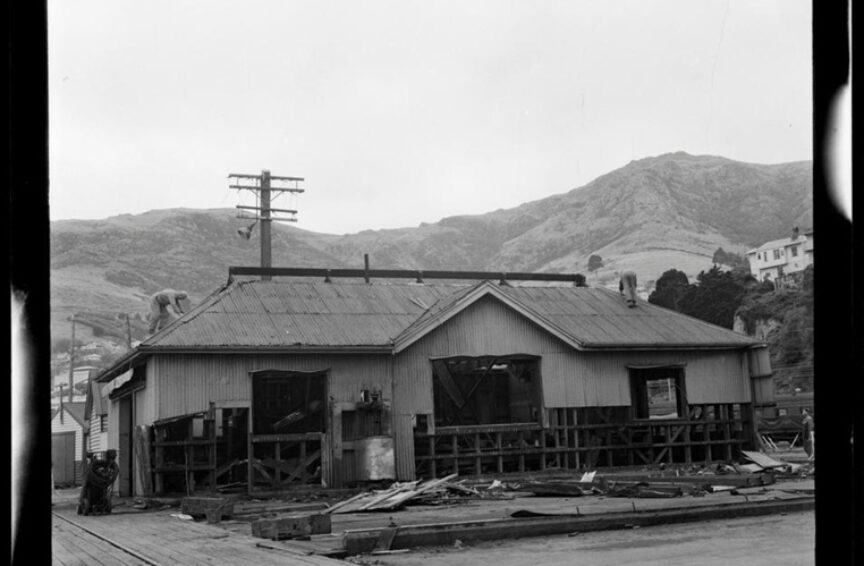PO Box 95
Lyttelton 8841
Te Ūaka recognises Te Hapū o Ngāti Wheke as Mana Whenua and Mana Moana for Te Whakaraupō / Lyttelton Harbour.
The Diamond Harbour Ferries
The Diamond Harbour ferry wharf at Lyttelton Port, once a favourite diving platform for school children in the summers of years gone by, also served local ferry services for well over a century, which ferries connected a number of jetties around Whakaraupō Lyttelton Harbour – from Te Waipapa Diamond Harbour, to Motu-kauati-iti Corsair Bay and Ōtoromiro Governors Bay. It was in 1852 that Mark Stoddart assumed ownership of the Diamond Harbour land and identified the necessity of a jetty to expedite the movement of goods and produce from his farm across the short distance by water to Ōhinehou Lyttelton’s port. The definitive date of Diamond Harbour’s jetty construction is not documented, but evidence from Stoddart's journal points to its existence by at least 1862. There are indications that its creation could be attributed to a ‘Mr. Grubb’, quite possibly John Grubb, the respected boat and wharf builder from Lyttelton.
Stoddart relinquished a significant portion of his Diamond Harbour land to his mortgage holders in 1871. By 1874, the land was marked for subdivision, and Harvey Hawkins, a well known entrepreneur from Ōhinehou Lyttelton, took possession in 1876. Hawkins constructed the notable Godley House on the headland, which gained popularity, or some might say notoriety, for its sociable events, with well to do guests from Christchurch arriving on steam ferries for weekend pleasantries.
Due to the increased popularity, a consistent ferry service was introduced from Ōhinehou Lyttelton to Te Waipapa Diamond Harbour by September 1891. The SS John Anderson plied a regular ferry service bringing revellers to Harvey Hawkins’ Godley House and its pleasure gardens, with the Lyttelton Port facilities being upgraded to support this increased traffic. At this time, there was discussion about charging for the use of the Diamond Harbour jetty, with complaints that passengers had been charged a 6 shilling landing fee on Boxing Day. However, the Lyttelton Harbour Board decided against such ‘entrepreneurship’, and the use of the Diamond Harbour jetty was declared free of charge to the public.
Despite the entry fees to his increasingly popular social facilities, Hawkins encountered financial difficulties in the early 1890s. He attempted to sustain himself by leasing the property for use as a hotel, pleasure gardens, and a park, but these efforts were unsuccessful. He eventually declared bankruptcy in 1894, and in 1897, the property reverted back to the Stoddart family. The impressionist painter Margaret Stoddart, daughter of Mark and Anna, lived there until 1913, creating a number of her most famous works. Meanwhile, the day trip by steam ferry across to the Godley House environs remained popular with weekend visitors from around the harbour and beyond.
A significant development occurred in 1913 when the Lyttelton Borough Council purchased 140 hectares of land from the Stoddart Estate, incorporating Diamond Harbour as a suburb of Lyttelton. The resulting growth in water traffic led to the addition of an 'L' shaped extension to the jetty in 1915, and from this time on it became known as the Diamond Harbour Wharf. By 1926, the growing suburb of some 38 houses, catered to tourists on the weekends for picnics, excursions and fishing parties, while the village’s professional residents and their children commuted daily to work and school via the steam ferry to Lyttelton port’s railway station and via locomotive to the city of Christchurch.
In 1928, in response to ever increasing water traffic, a prohibition was placed on private boats mooring at the wharf, facilitating easier disembarkation for ferry passengers. Despite decades-long difficulties in procuring a reliable water supply, the village continued to grow through the thirties and beyond. It was from this time that the Diamond Harbour ferries – such as the Owaka, Moturata, Reo Moana, Manuka, and the Awhinanui, followed by Onawe and today’s Black Diamond – came to symbolise the harbour way of life we know and love today.

